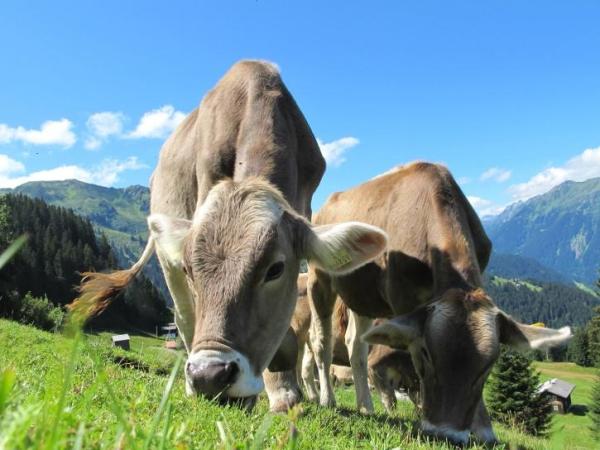How Many Stomachs Does a Cow Have and Why?


Many people believe that cows have 4 stomachs. Some even go on to say that they have 4 or 7 stomachs. This is completely incorrect. Cows only have one stomach, however, that stomach is divided into 4 compartments: rumen, reticulum, omasum and abomasum.
In this AnimalWised article we're going to explain how many stomachs cows have and why. We'll go deeper into a cow's digestive system and explain how they digestive their food.
What are ruminant animals?
Ruminant animals are exclusively herbivores that feed on stems, grasses and herbaceous materials, having a complex digestion system to transform food into simpler compounds and to take advantage of their chemical components, thus being able to nourish themselves. The plants that ruminants feed on are made up of a high content of cellulose, which can only be used thanks to the anatomy of the digestive system of these animals, which also has specialized microorganisms that contribute to the process.
Rumination properly consists of re-chewing the food that had already been swallowed. In this sense, these animals mix with saliva and lightly chew the food and pass it to the esophagus so that it is then taken to the stomach. But in this process, the larger particles are regurgitated into the mouth to be chewed again and later re-ingested.

Cow's digestive system
Cows can consume an average of 70 kg of grass per day during a period of 8 hours. They can do this thanks to their peculiar anatomical and physiological system that carries out their digestion. Before we look into a cow's stomach and its compartments, let's take a look at a cow's digestive system.
The digestive system of the cow is made up of:
- Mouth: that has a strong tongue and teeth. The tongue is made up of different papillae that give it its rough texture. Their tongue is also long, since it has an apprehension function, so that it rolls it in the grass, introduces it in the mouth and with the use of the lower incisor teeth it makes the cut, crushing it slightly and obtaining the grass. This procedure is repeated several times until a mass of approximately 100 g is obtained. That is then mixed with saliva, forming a bolus that is then swallowed. The saliva of cows is formed in large quantities and is produced by various glands, secreting different substances to facilitate the wetting of the pasture and its chewing, but also to control the pH of the bolus during the digestive process.
- Esophagus: the bolus, which is already a mixture lightly chewed and mixed with saliva, passes through the pharynx until it reaches the esophagus, from where it is transported to the stomach.
- Stomach: it is a sac-like structure that begins with the end of the esophagus and ends in the duodenum. It is made up of several parts, which we will discuss later, and it is particularly home to different specialized microorganisms that are essential for a cow's digestive system.
You may also be interested in our article about why cows are sacred in India.
How many stomachs do cows have and why?
Many people believe that cows have 4 stomachs. Some even go on to say that they have 4 or 7 stomachs. This is completely incorrect. Contrary to popular belief, cows only have one stomach, however, that stomach is divided into 4 compartments: rumen, reticulum, omasum and abomasum. Cows have this type of stomach and digestive system because they are ruminant animals that eat large amounts of grass and they need a digestive system that can help them break down and receive all the nutrients the need from their diet.
Each of these compartments are important in a cow's digestive process, helping them break down their food and receive all the nutrients they need. Now that we understand the misconception of how many stomachs cows have, let's take a look at why they have 4 compartments and what each one of those compartments do.
The 4 compartments of a cow's stomach
So, why does a cow have 4 compartments in their stomach? Let's take a look at each compartment and their function:
- Rumen: in this compartment we can find microorganisms that start the fermentation of the food bolus in order to transform it. This is the largest compartment of all, being able to have a capacity of up to 200 liters. Certain products of fermentation are already absorbed by the rumen walls and pass into the bloodstream. Other compounds that are not fermented, are transformed into proteins used by the animal. The time the food remains in this area can vary, about 12 hours for the more liquid fraction, and between 20 to 48 hours for the fibrous portion.
- Reticulum: this chamber has the function of containing the food and transporting it back to the cow's mouth to be further chewed after being digested in the rumen compartment.
- Omasum: this compartment is characterized by being made up of various folds, which is why it is also known as a booklet. The function of the cow's omasum is to absorb excess water so that the feed passes to the next structure as concentrated as possible and the enzymes involved in digestion have not been diluted.
- Abomasum: this is the stomach of the animal itself. The acidity of this area is high, which is why all the microorganisms that were processing the food are digested here, also stopping the fermentation. Hydrochloric acid and pepsin are produced, favoring the processing of proteins that have reached the area, causing a chemical digestion of food. This is the last compartment the food will go through before being brought to the small intestines to have all its nutrients extracted.

Other digestive structures of these animals are:
- Small intestine: here is where all the nutrients from the food will be extracted. Once the food has been digested by the four compartments of a cow's stomach they will go to the small intestine.
- Caecum: the mass of food that has not been digested passes through the caecum.
- Large intestine: in the large intestine, the components not yet digested will be processed by a less prolific population of microorganisms that will undergo a new fermentation to extract as much nutrients as possible.
- Colon: the cow's colon is the place where the absorption of water and minerals occurs, to later form the fecal matter that will be eliminated through the rectum canal.
Watch the video below to understand how a cow's digestive system works! We also encourage you to check out our article about the 5 most intelligent animals in the world.

If you want to read similar articles to How Many Stomachs Does a Cow Have and Why?, we recommend you visit our Facts about the animal kingdom category.
- J. García y M. Gingins. (1969). Anatomía y fisiología del aparato digestivo de rumiantes. Disponible en: http://www.produccion-animal.com.ar/informacion_tecnica/manejo_del_alimento/02-anatomia_fisiologia_digestivo.pdf
- Gloobe, H. (1989). Anatomía aplicada del bovino. Bib. Orton IICA / CATIE. Disponible en: https://books.google.co.ve/books?id=MeU2Ru8k1qoC&printsec=frontcover&hl=es&redir_esc=y#v=onepage&q&f=false :
- Ng, J. (2001). Bos Taurus. Animal Diversity Web. Disponible en: https://animaldiversity.org/accounts/Bos_taurus/







